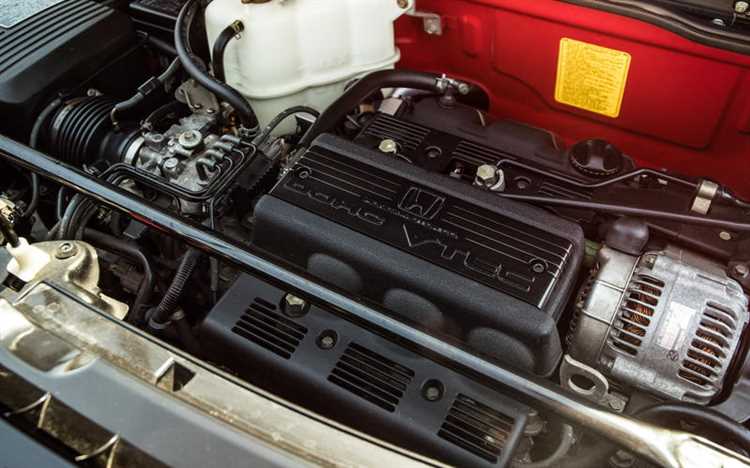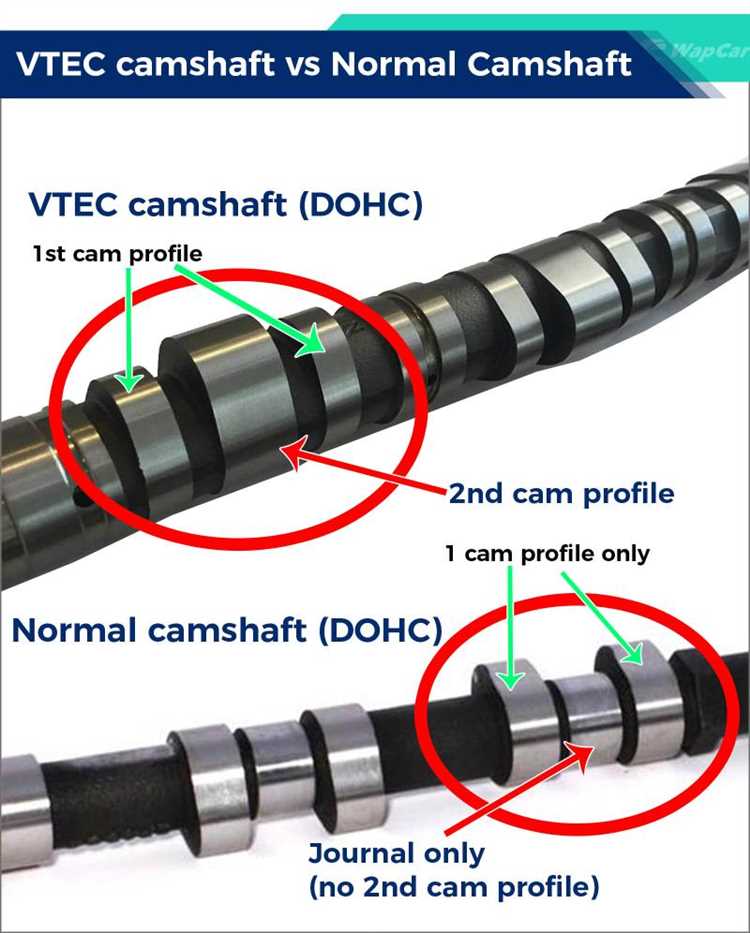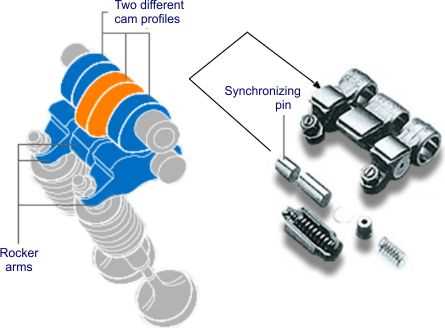
When it comes to automotive performance, Honda has always been at the forefront of innovation. One of their most significant contributions to the industry is their Variable Valve Timing and Lift Electronic Control (VTEC) technology. Introduced in the late 1980s, VTEC revolutionized the way engines operate, boosting both power and efficiency.
At its core, VTEC is a valve train system that allows engines to have multiple camshaft profiles. This means that the engine can switch between different valve timing and lift configurations, depending on the driving conditions. The result is improved power delivery throughout the engine’s RPM range.
One of the key advantages of VTEC is its ability to increase power output without sacrificing fuel efficiency. By optimizing valve timing and lift, Honda’s VTEC engines are able to provide more power when needed, while still maintaining good fuel economy during normal driving conditions. This makes VTEC-equipped vehicles a popular choice among car enthusiasts who want both performance and efficiency.
Another notable impact of Honda’s VTEC technology is its effect on engine responsiveness. By allowing for more precise control of the valves, VTEC engines can respond quickly to throttle inputs, resulting in a more engaging driving experience. This responsiveness is particularly noticeable at higher RPMs, where VTEC engines truly shine.
In conclusion, Honda’s VTEC technology has had a significant impact on automotive performance. By optimizing valve timing and lift, VTEC engines are able to provide increased power, improved fuel efficiency, and enhanced engine responsiveness. Whether you’re a car enthusiast or simply looking for a reliable and efficient vehicle, Honda’s VTEC technology is certainly worth considering.
The Evolution of Honda’s VTEC Technology
Honda’s VTEC (Variable Valve Timing and Lift Electronic Control) technology has undergone significant evolution since its introduction in the late 1980s. Originally developed as a way to enhance performance while maintaining fuel efficiency, VTEC has become a hallmark of Honda’s engineering prowess.
One of the key innovations in the evolution of VTEC technology is the introduction of dual-stage VTEC. This technology allows for both low-end torque and high-end power, offering a broader power band and improved overall performance. By utilizing different cam profiles at different engine speeds, Honda has been able to optimize performance across a wide range of driving conditions.
Another important development in the evolution of VTEC is the integration of VTEC with other advanced engine technologies. Honda’s VTEC engines have been combined with technologies such as direct injection, turbocharging, and hybridization to further enhance performance and efficiency. This integration of VTEC with other technologies has allowed Honda to stay at the forefront of automotive innovation.
In recent years, Honda has also focused on improving the environmental impact of its VTEC engines. The latest iteration of VTEC technology includes features such as cylinder deactivation, which shuts down cylinders when they are not needed, reducing fuel consumption and emissions. This commitment to environmental sustainability demonstrates Honda’s dedication to continuously improving its VTEC technology.
Looking ahead, the future of VTEC technology is promising. Honda continues to invest in research and development to further improve performance, efficiency, and environmental friendliness. With new advancements on the horizon, the impact of Honda’s VTEC technology on automotive performance is set to continue evolving and pushing the boundaries of what is possible.
The Birth of VTEC: Revolutionizing Engine Performance
The Variable Valve Timing and Lift Electronic Control system, commonly known as VTEC, is a technological innovation developed by Honda to revolutionize engine performance in the automotive industry. Introduced in the early 1990s, VTEC quickly gained popularity due to its ability to enhance both power and efficiency.
VTEC works by adjusting the timing and lift of the engine’s valves, allowing for optimal airflow and fuel combustion. This technology enables an engine to operate in two different camshaft profiles: a low-speed profile for efficiency and a high-speed profile for power. By seamlessly switching between these profiles, VTEC provides a smooth and responsive driving experience.
One of the key benefits of VTEC is its ability to boost power without sacrificing fuel efficiency. When the engine operates in its low-speed profile, the valves open for a shorter duration, reducing fuel consumption. However, when the engine reaches higher RPMs, the valves switch to the high-speed profile, increasing airflow and power output.
In addition to improving power and efficiency, VTEC also enhances engine response and performance at different RPM ranges. This technology allows for better acceleration and overall driving dynamics, making Honda vehicles equipped with VTEC highly sought after by performance enthusiasts.
Furthermore, VTEC has had a significant impact on the automotive industry as a whole. Its introduction marked a shift towards more advanced and efficient engine technologies, and it has inspired other manufacturers to develop their own versions of variable valve timing systems.
In conclusion, the birth of VTEC revolutionized engine performance by providing a balance between power and efficiency. This technology has become synonymous with Honda’s commitment to innovation, and it continues to be a defining feature of their vehicles. With its ability to optimize valve timing and lift, VTEC has set a new standard for performance in the automotive industry.
Advantages of VTEC: Increasing Power and Efficiency
The VTEC (Variable Valve Timing and Lift Electronic Control) technology developed by Honda has revolutionized automotive performance by increasing power and improving efficiency. This innovative system allows for optimal control of the engine’s valves, resulting in a more efficient combustion process and improved overall performance.
One of the key advantages of VTEC is its ability to increase power output. By adjusting the valve timing and lift, VTEC enables the engine to operate at higher RPMs, allowing for more air and fuel to enter the combustion chamber. This leads to increased power output, providing drivers with a thrilling driving experience.
VTEC also improves engine efficiency by optimizing the combustion process. By adjusting the valve timing and lift based on driving conditions, VTEC ensures that the engine operates at its most efficient level. This results in improved fuel economy and reduced emissions, making VTEC-equipped vehicles more environmentally friendly.
Furthermore, VTEC enhances the overall responsiveness of the engine. By adjusting the valve timing and lift, VTEC allows for quick and precise changes in power delivery, resulting in a more agile and dynamic driving experience. This responsiveness is particularly beneficial in situations where rapid acceleration or passing maneuvers are required.
In addition to these performance benefits, VTEC is also known for its reliability and durability. Honda’s VTEC engines have a reputation for longevity and are often praised for their ability to deliver consistent performance over time. This reliability further enhances the appeal of VTEC technology.
In conclusion, the advantages of Honda’s VTEC technology are clear. By increasing power output, improving efficiency, enhancing responsiveness, and offering reliability, VTEC has had a significant impact on automotive performance. Whether it’s on the race track or the daily commute, VTEC-equipped vehicles provide drivers with an exhilarating and efficient driving experience.
The Development of VTEC

VTEC, short for Variable Valve Timing and Lift Electronic Control, is a technology developed by Honda to enhance the performance and efficiency of their engines. The development of VTEC began in the late 1980s as Honda engineers recognized the need for a system that could optimize valve timing and lift for different engine speeds and loads.
The key concept behind VTEC is its ability to switch between different camshaft profiles, allowing the engine to operate with both high power and high efficiency characteristics. This is achieved by using multiple rocker arms, each with its own set of cam lobes. At lower engine speeds, the VTEC system engages the low lift, short duration cam lobes for improved fuel efficiency. As the engine speed increases, the VTEC system switches to the high lift, long duration cam lobes for increased power output.
One of the major challenges during the development of VTEC was designing a system that could seamlessly transition between the different camshaft profiles without causing any drivability issues. Honda engineers achieved this by using an innovative hydraulic system that could quickly and precisely control the movement of the rocker arms. This allowed for smooth and precise transitions between the camshaft profiles, resulting in a seamless and responsive driving experience.
The development of VTEC also involved extensive testing and refinement to ensure its reliability and durability. Honda engineers conducted rigorous testing on various engines and vehicles to validate the performance and efficiency benefits of VTEC. The system was continuously improved and refined over the years, with each new iteration offering better performance and efficiency.
Today, VTEC is a widely recognized and celebrated technology in the automotive industry. It has become synonymous with Honda’s commitment to high-performance engines that deliver both power and efficiency. The development of VTEC showcases Honda’s dedication to innovation and pushing the boundaries of automotive engineering to create better driving experiences.
Continuous Improvements: Enhancing Performance and Fuel Economy
In the pursuit of innovation and excellence, Honda has continuously worked on enhancing the performance and fuel economy of their vehicles. Through their cutting-edge VTEC technology, they have achieved remarkable improvements in both these areas.
The VTEC (Variable Valve Timing and Lift Electronic Control) system, introduced by Honda in the 1980s, has evolved and undergone continuous improvements over the years. This technology allows for variable valve timing, which optimizes the engine’s performance at different speeds and loads.
One of the key benefits of VTEC technology is its ability to enhance power and torque delivery. By adjusting the valve timing and lift, the engine can achieve better combustion efficiency, resulting in increased power output. This means that Honda vehicles equipped with VTEC engines can deliver greater acceleration and overall performance.
Furthermore, the VTEC system also contributes to improved fuel economy. By optimizing the valve timing, the engine can operate more efficiently, reducing fuel consumption. This is particularly noticeable during low-speed driving and cruising, where the engine can run on a reduced number of cylinders, further enhancing fuel efficiency.
In addition to the VTEC technology itself, Honda has incorporated other advanced features and innovations to enhance performance and fuel economy. For example, the use of lightweight materials and aerodynamic design elements helps reduce weight and drag, improving the overall efficiency of the vehicle.
Overall, Honda’s continuous improvements in performance and fuel economy through their VTEC technology have made their vehicles stand out in the automotive industry. With each new iteration, Honda continues to push the boundaries of what is possible, delivering powerful and efficient vehicles that provide an exceptional driving experience.
Dynamic VTEC: Unleashing the Full Potential of Honda Engines
The Variable Valve Timing and Lift Electronic Control (VTEC) technology developed by Honda has revolutionized the automotive industry, providing both power and efficiency in their engines. With the introduction of Dynamic VTEC, Honda has taken engine performance to a whole new level.
Dynamic VTEC is an advanced version of the traditional VTEC system, allowing Honda engines to deliver enhanced performance across a wider range of engine speeds. By optimizing valve timing and lift, Dynamic VTEC enables the engine to generate more power and torque, resulting in improved acceleration and overall performance.
One of the key features of Dynamic VTEC is its ability to seamlessly transition between low and high-speed cam profiles. At low engine speeds, the valve timing and lift are optimized for fuel efficiency, providing a smooth and efficient driving experience. As the engine speed increases, Dynamic VTEC engages the high-speed cam profile, allowing for increased airflow and improved performance.
Another advantage of Dynamic VTEC is its ability to adapt to different driving conditions. Whether it’s cruising on the highway or tackling twisty roads, the system adjusts the valve timing and lift to optimize power delivery and responsiveness. This ensures that the engine delivers the right amount of power when it’s needed, resulting in a dynamic and exhilarating driving experience.
Furthermore, Dynamic VTEC plays a crucial role in reducing emissions and improving fuel efficiency. By precisely controlling the valve timing and lift, the system maximizes combustion efficiency, reducing wasted fuel and minimizing harmful emissions. This makes Honda engines equipped with Dynamic VTEC not only powerful and responsive but also environmentally friendly.
In conclusion, Dynamic VTEC is a testament to Honda’s commitment to innovation and performance. By unleashing the full potential of their engines, Honda has created a technology that delivers both power and efficiency, providing drivers with an exhilarating and environmentally conscious driving experience. Whether it’s on the highway or the racetrack, Dynamic VTEC sets Honda engines apart from the competition.
The Impact of VTEC on Automotive Performance

The VTEC (Variable Valve Timing and Lift Electronic Control) technology developed by Honda has had a significant impact on automotive performance. By allowing for variable valve timing and lift, VTEC enhances both power and efficiency in Honda engines.
One of the main benefits of VTEC is its ability to optimize engine performance at different RPM ranges. By adjusting the timing and lift of the valves, VTEC allows for improved combustion efficiency and increased power output. This means that Honda engines equipped with VTEC can deliver strong acceleration and high torque at high RPMs, while still maintaining fuel efficiency at lower RPMs.
VTEC also improves engine breathing, which is crucial for performance. By adjusting the valve lift, VTEC enables better intake and exhaust flow, allowing the engine to breathe more easily. This leads to improved power delivery and throttle response, making the vehicle more responsive and enjoyable to drive.
Furthermore, VTEC technology contributes to improved fuel efficiency. By optimizing valve timing and lift, VTEC helps to reduce pumping losses and improve combustion efficiency. This means that Honda engines equipped with VTEC can achieve better fuel economy, reducing both emissions and the owner’s fuel costs.
Overall, VTEC has had a transformative impact on automotive performance. By enhancing power, efficiency, and throttle response, VTEC has made Honda vehicles more enjoyable to drive while also delivering improved fuel economy. As a result, VTEC has become a hallmark of Honda’s engineering excellence and a key factor in the brand’s reputation for producing high-performance vehicles.